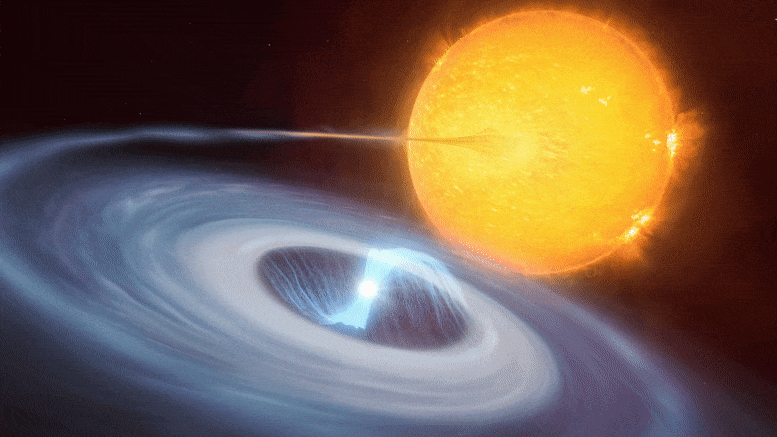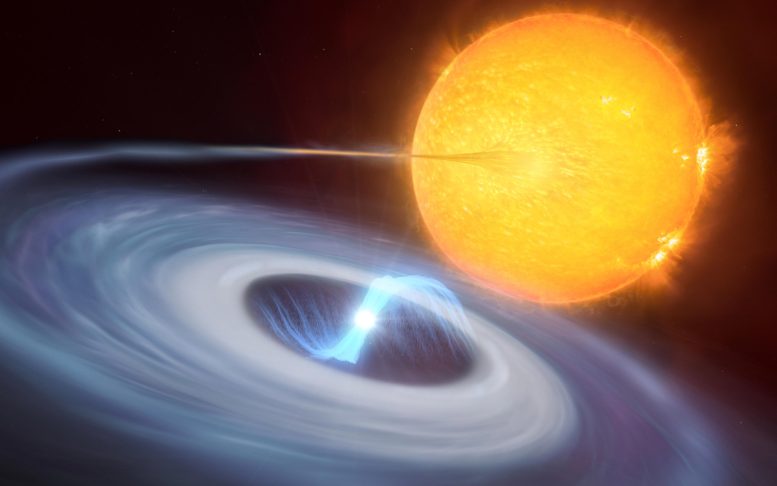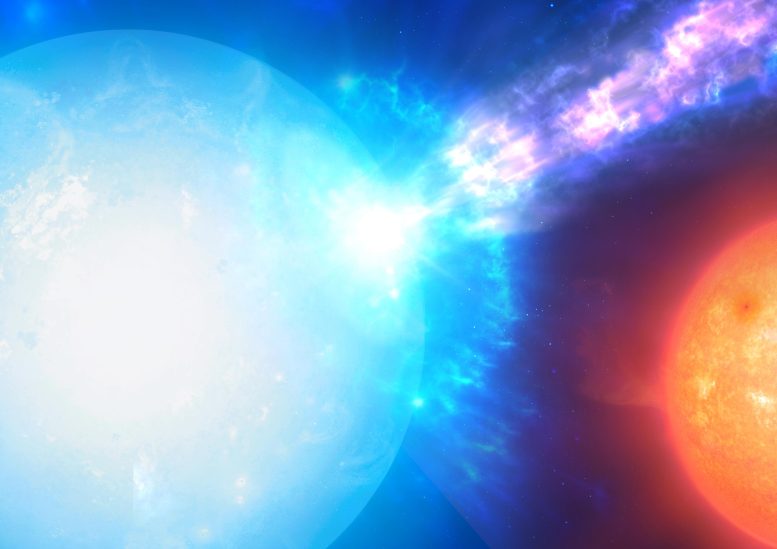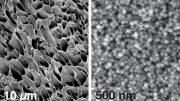
Using ESO’s Very Large Telescope, a team of astronomers has observed a new type of stellar explosion — a micronova.
A team of astronomers, with the help of the European Southern Observatory’s Very Large Telescope (ESO’s VLT), has observed a new type of stellar explosion — a micronova. These outbursts happen on the surface of certain stars, and can each burn through around 3.5 billion Great Pyramids of Giza of stellar material in only a few hours.
“We have discovered and identified for the first time what we are calling a micronova,” explains Simone Scaringi, an astronomer at Durham University in the UK who led the study on these explosions published on April 20 in the journal Nature. “The phenomenon challenges our understanding of how thermonuclear explosions in stars occur. We thought we knew this, but this discovery proposes a totally new way to achieve them,” he adds.
Astronomers have discovered a new type of explosion occurring on white dwarf stars in two-star systems. This video summarizes the discovery.
Micronovae are extremely powerful events, but are small on astronomical scales; they are much less energetic than the stellar explosions known as novae, which astronomers have known about for centuries. Both types of explosions occur on white dwarfs, dead stars with a mass about that of our Sun, but as small as Earth.
A white dwarf in a two-star system can steal material, mostly hydrogen, from its companion star if they are close enough together. As this gas falls onto the very hot surface of the white dwarf star, it triggers the hydrogen atoms to fuse into helium explosively. In novae, these thermonuclear explosions occur over the entire stellar surface. “Such detonations make the entire surface of the white dwarf burn and shine brightly for several weeks,” explains co-author Nathalie Degenaar, an astronomer at the University of Amsterdam, the Netherlands.

This artist’s impression shows a two-star system where micronovae may occur. The blue disc swirling around the bright white dwarf in the center of the image is made up of material, mostly hydrogen, stolen from its companion star. Towards the center of the disc, the white dwarf uses its strong magnetic fields to funnel the hydrogen towards its poles. As the material falls on the hot surface of the star, it triggers a micronova explosion, contained by the magnetic fields at one of the white dwarf’s poles. Credit: ESO/M. Kornmesser, L. Calçada
Micronovae are similar explosions that are smaller in scale and faster, lasting just several hours. They occur on some white dwarfs with strong magnetic fields, which funnel material towards the star’s magnetic poles. “For the first time, we have now seen that hydrogen fusion can also happen in a localized way. The hydrogen fuel can be contained at the base of the magnetic poles of some white dwarfs, so that fusion only happens at these magnetic poles,” says Paul Groot, an astronomer at Radboud University in the Netherlands and co-author of the study.
“This leads to micro-fusion bombs going off, which have about one millionth of the strength of a nova explosion, hence the name micronova,” Groot continues. Although ‘micro’ may imply these events are small, do not be mistaken: just one of these outbursts can burn through about 20,000,000 trillion kg, or about 3.5 billion Great Pyramids of Giza, of material.[1]

This artist’s impression shows a two-star system, with a white dwarf (in the foreground) and a companion star (in the background), where micronovae may occur. The white dwarf steals materials from its companion, which is funneled towards its poles. As the material falls on the hot surface of the white dwarf, it triggers a micronova explosion, contained at one of the star’s poles. Credit: Mark Garlick
These new micronovae challenge astronomers’ understanding of stellar explosions and may be more abundant than previously thought. “It just goes to show how dynamic the Universe is. These events may actually be quite common, but because they are so fast they are difficult to catch in action,” Scaringi explains.
The team first came across these mysterious micro-explosions when analyzing data from NASA’s Transiting Exoplanet Survey Satellite (TESS). “Looking through astronomical data collected by NASA’s TESS, we discovered something unusual: a bright flash of optical light lasting for a few hours. Searching further, we found several similar signals,” says Degenaar.
This video shows an animation of a micronova explosion. The blue disc swirling around the bright white dwarf in the center of the image is made up of material, mostly hydrogen, stolen from its companion star. Towards the center of the disc, the white dwarf uses its strong magnetic fields to funnel the hydrogen towards its poles. As the material falls on the hot surface of the star, it triggers a micronova explosion, contained by the magnetic fields at one of the white dwarf’s poles. Credit: ESO/L. Calçada, M. Kornmesser
The team observed three micronovae with TESS: two were from known white dwarfs, but the third required further observations with the X-shooter instrument on ESO’s VLT to confirm its white dwarf status.
“With help from ESO’s Very Large Telescope, we found that all these optical flashes were produced by white dwarfs,” says Degenaar. “This observation was crucial in interpreting our result and for the discovery of micronovae,” Scaringi adds.
This artist’s animation shows a two-star system where one of the components is a normal star and the other is a white dwarf, which appears surrounded by a disc of gas and dust. A white dwarf in a two-star system can steal material, mostly hydrogen, from its companion star if they are close enough together. Credit: ESO/M. Kornmesser
The discovery of micronovae adds to the repertoire of known stellar explosions. The team now want to capture more of these elusive events, requiring large-scale surveys and quick follow-up measurements. “Rapid response from telescopes such as the VLT or ESO’s New Technology Telescope and the suite of available instruments will allow us to unravel in more detail what these mysterious micronovae are,” Scaringi concludes.
Reference: “Localized thermonuclear bursts from accreting magnetic white dwarfs” by S. Scaringi, P. J. Groot, C. Knigge, A. J. Bird, E. Breedt, D. A. H. Buckley, Y. Cavecchi, N. D. Degenaar, D. de Martino, C. Done, M. Fratta, K. Iłkiewicz, E. Koerding, J.-P. Lasota, C. Littlefield, C. F. Manara, M. O’Brien, P. Szkody and F. X. Timmes, 20 April 2022, Nature.
DOI: 10.1038/s41586-022-04495-6
Notes
- We use trillion to mean a million million (1,000,000,000,000 or 1012) and billion to mean a thousand million (1,000,000,000 or 109). The weight of the Great Pyramid of Giza in Cairo, Egypt (also known as the Pyramid of Khufu or Pyramid of Cheops) is about 5,900,000,000 kg.
More information
This research was presented in a paper title “Localised thermonuclear bursts from accreting magnetic white dwarfs” to appear in Nature. A follow-up letter, titled “Triggering micronovae through magnetically confined accretion flows in accreting white dwarfs” has been accepted for publication in Monthly Notices of the Royal Astronomical Society.
The team on the Nature paper is composed of S. Scaringi (Centre for Extragalactic Astronomy, Department of Physics, Durham University, UK [CEA]), P. J. Groot (Department of Astrophysics, Radboud University, N?megen,the Netherlands [IMAPP] and South African Astronomical Observatory, Cape Town, South Africa [SAAO] and Department of Astronomy, University of Cape Town, South Africa [Cape Town]), C. Knigge (School of Physics and Astronomy, University of Southampton, Southampton, UK [Southampton]), A.J. Bird (Southampton) , E. Breedt (Institute of Astronomy, University of Cambridge, UK), D. A. H. Buckley (SAAO, Cape Town, Department of Physics, University of the Free State, Bloemfontein, South Africa), Y. Cavecchi (Instituto de Astronomía, Universidad Nacional Autónoma de México, Ciudad de México, México), N. D. Degenaar (Anton Pannekoek Institute for Astronomy, University of Amsterdam, Amsterdam, the Netherlands), D. de Martino (INAF-Osservatorio Astronomico di Capodimonte, Naples, Italy), C. Done (CEA), M. Fratta (CEA), K. Ilkiewicz (CEA), E. Koerding (IMAPP), J.-P. Lasota (Nicolaus Copernicus Astronomical Center, Polish Academy of Sciences, Warsaw, Poland and Institut d’Astrophysique de Paris, CNRS et Sorbonne Universités, Paris, France), C. Littlefield (Department of Physics, University of Notre Dame, USA and Department of Astronomy, University of Washington, Seattle, USA [UW]), C. F. Manara (European Southern Observatory, Garching, Germany [ESO]), M. O’Brien (CEA), P. Szkody (UW), F. X. Timmes (School of Earth and Space Exploration, Arizona State University, Arizona, USA, Joint Institute for Nuclear Astrophysics – Center for the Evolution of the Elements, USA).









So, What if “The team first came across these mysterious micro-explosions when analyzing data from NASA’s Transiting Exoplanet Survey Satellite (TESS)”, they don’t tell us which Stars are doing this, you can’t get to there study unless you pay to get pass the wall…
Schone gruss beliben sie gusend.god bless you.rajveer singh